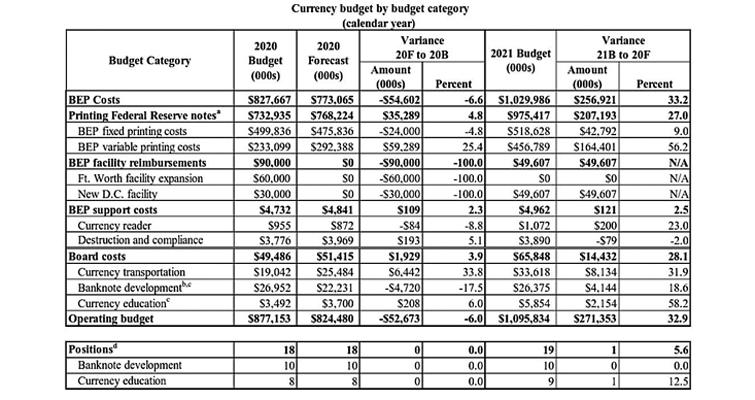Fed budget reveals increased production orders to BEP Community Comments
The Federal Reserve Board’s currency budget for the 2021 calendar year is listed in a report released by the agency as $1,095,800,000, an increase of $271.4 million, or 32.9 percent, over the 2020 forecasted expenses of $824.5 million.
The sum includes $1,030.0 million in Bureau of Engraving and Printing costs and $65.8 million in board costs. The increase is attributed mostly to higher Federal Reserve note printing costs due to a demand for cash created by the COVID-19 pandemic.
A footnote in the report explains that the board reimburses the BEP for all costs related to the production of currency, because the BEP does not receive federal appropriations. The Federal Reserve Act requires that all costs for the issuing of notes be paid for by the board and included in its assessments to the Reserve Banks. All operations and capital investments of the BEP are financed by a revolving fund that is reimbursed through sales, mostly those of Federal Reserve notes to the board to fulfill its annual print order.
The report provides some under-the-radar details. Comments about the 2020 operating budget disclosed that it would be 6% less than the originally budgeted amount. One factor was a 17.5% drop in note development costs that it says were “adjusted in response to a termination of a design services contract for the next family of notes.” Other factors were delays for some projects that were impacted by the COVID-19 pandemic, and new contracts that took longer to procure than expected.

COVID-19 also had an impact in the opposite direction, resulting in higher costs in some areas. In total, 627.2 million notes were added to the original 2020 fiscal year print order, due to high demand for paper currency and to replenish depleted inventories. The year’s print order was also amended to emphasize production of $20 through $100 denominations. These were subject to greater increases in demand for a longer period than the lower denominations of $1 through $10.
The higher demand also led to higher shipping costs from the BEP facilities to the Federal Reserve banks. While lower denominations are normally shipped by surface transport, the higher denomination notes usually ship by air, making the costs higher. Air shipping became higher than in previous years because “alternative transportation methods,” such as chartered aircraft, are six times more expensive than commercial aircraft, and such methods were needed “to provide just-in-time shipments of cash to Reserve Banks with depleted inventory” to meet market demand.
Also included in the budget are costs for resuming funding of the new BEP facility in the Washington, D.C., area and an expansion of the one in Fort Worth, Texas. The total costs for Washington are estimated at $1.4 billion. A total of $49 million is being provided to the BEP this year for design and site demolition costs. An expansion in Fort Worth should be completed in 2023 at a total cost of $29.9 million.
Connect with Coin World: Sign up for our free eNewsletterAccess our Dealer Directory Like us on Facebook Follow us on Twitter

